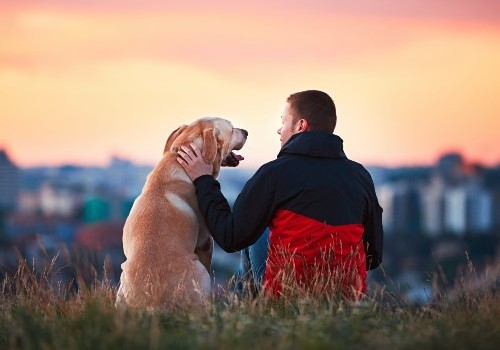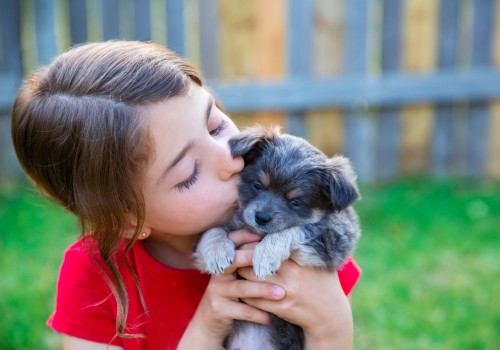Ever had a day that left you feeling down, only to come home and find your dog being uncharacteristically gentle?
Rather than barking, jumping, and begging you for attention, he comes up to you and nuzzles you, then lays down in your lap. It’s almost like he can tell you’re having a bad day and wants to comfort you.
But do dogs actually know when you’re sad?
Is their changed behavior response to your moods? A coincidence? Or the result of something else entirely?
Well, we can’t exactly ask our dogs why they do the things they do — but we can consult some scientists who have some pretty good theories!
Do Dogs Feel What We Feel? (Dogs and Emotions)

Throughout the history of animal science, one question has proved especially controversial: do animals feel the same emotions we do?
Today, science has caught up with what dog owners have intuitively known for centuries: they do.
And the emotions they feel are remarkably similar to ours.
Neuroscientist Gregory Berns demonstrated this by conducting a landmark experiment in which dogs were given MRI scans while being presented with various stimuli designed to elicit emotions.
For instance, the dogs were trained to associate a certain hand signal with being given treats, and another with being denied treats. As each signal was shown, a different area of the dog’s brain lit up on the MRI.
This suggested that different emotions were being felt according to the meaning of the signal.
But the implications went even further: the areas of the brain that lit up corresponded to the areas of the human brain that activate when we experience the same emotions.
The experiment demonstrated that dogs feel emotions that are analogous to ours — a big first step towards finding out if they know when we’re sad.
Paving the Way for Canine Empathy
Once it was established that dogs feel happiness, sadness, anxiety, excitement, and other emotions previously thought of as exclusively human, another question was raised: do dogs understand what we’re feeling?
A canine empathy study conducted in 2018 demonstrated that they do.
In the experiment, dogs were separated from their owners by a clear glass door held shut by magnets. The owners were instructed to do one of two things: hum a song or pretend to cry.
The humming was intended to be a novelty that would pique the dogs’ curiosity and make them want to open the door. On the other hand, the researchers wanted to see if crying would also prompt the dogs to open the door in order to comfort their owners.
And while both behaviors made the dogs open the door, there was a clear difference in the end results.
Dogs whose owners were crying opened the door three times faster than those whose owners were humming, suggesting that they could understand signs of distress — and that they wanted to help.
In response to their owners crying, some dogs even became so stressed out themselves that they were unable to open the door. If you’ve ever started crying because someone you love was crying, you can probably relate to this response.
These results show that not only do dogs experience empathy, but individual dogs also experience it to different degrees and express it differently.
Sadness or Conditioning: Do Dogs Really Know the Difference?

Studies involving dogs and their owners are tricky because of the preexisting relationship between the two parties.
A dog’s response to his owner crying could be because the pup inherently understands sadness — or it could be a learned behavior, slowly conditioned over years of interactions.
So can they actually recognize various emotions? Or are they responding to specific behavioral cues that they’ve learned over time?
Researchers from the University of London and the University of Sao Paulo decided to find out.
They put together a multimedia slideshow: images of dogs and humans making various facial expressions, and sound recordings of barks and vocalizations.
In some cases, the images and sounds matched — a smiling human speaking in a joyful tone, an angry dog growling — and in others, they didn’t — a smiling human crying, a relaxed dog barking aggressively. The image-audio pairs were then shown to various dogs, whose reactions were recorded.
The goal was to see if the dogs could combine the two sources of sensory inputs in order to understand the emotion being displayed.
And the results showed that they could. The dogs spent significantly longer looking at the images when the audio and facial expressions matched — and that held true whether the image was of a dog or a human.
What’s more, none of the dogs had received any training before going through the experiment. This suggests that they have an intrinsic understanding of emotions, both human and canine.
How Dogs Detect Sadness: Is Smell the Secret?

We depend on our eyes and ears for much of our perception, but for dogs, smell plays a much larger role than any other sense.
And it may be the secret to their amazing emotion-detecting abilities.
Different emotions cause us to produce different hormones, which are then secreted through sweat, tears, and other bodily fluids.
Low serotonin levels, for instance, indicate a depressed mood, while high dopamine levels indicate excitement and pleasure. High cortisol levels indicate stress, anxiety, and agitation.
Each hormone has a unique scent that’s far too faint for us to pick up on — but dogs can smell it, and they seem to know what each hormone means.
A study conducted at the University of Naples put this theory to the test. Researchers showed people one of two videos — one designed to induce happiness, the other designed to induce fear.
They collected sweat samples from the subjects, then presented the sweat to dogs and had them sniff it. Present in the room with each dog were the owner and a stranger, though neither interacted with the dog.
The dogs that smelled the “happy” sweat became more relaxed and interested in interacting with the strangers. Meanwhile, the dogs that smelled the “fear” scent displayed signs of stress and began seeking comfort from their owners while avoiding the strangers.
So perhaps your dog’s main clue to your sad mood is actually the scent of your low serotonin. In this way, he may understand what you’re feeling even before you figure it out for yourself — isn’t it amazing what a dog’s nose knows?
How Do Dogs React When Their Owners Are Sad?
All of these studies confirm what we dog lovers have always suspected. Our dogs do know when we’re sad, and the empathy they feel is strong enough to influence their own emotions and behaviors.
So how does that manifest outside of a laboratory?
Next time you’re feeling blue, watch your dog for these signs that demonstrate his emotion-detecting abilities. Look closely and you may even see him fine-tune his behavior to match your precise variety of sadness.
A Need for Physical Contact

No matter how old you are, sometimes a loving embrace is just what you need to get out of a funk and remember the good things in life.
And this isn’t limited to humans, either. Dogs also feel comforted and cared for when they’re touched — and they’re able to apply this knowledge to the people in their life.
If you’re crying on the couch, your dog may drop what he’s doing and come to you for some cuddles. He’ll touch his paw to your hand and rest his head in your lap, or he might try to make as much bodily contact with you as possible.
It may seem like he’s being needy at first, but it’s actually the opposite. He’s decided that right now, your feelings are the most important thing, and he wants to soothe you in the best way he knows how.
Time for a Distraction
We don’t know if dogs mentally dwell on things the way we do. They may or may not randomly remember sad things throughout the day, and times of deep sorrow may or may not drag out for days in their heads.
But dogs do seem to understand when we’re ruminating on things, and their advice is so good it should qualify them to be therapists: distract yourself!
If you’re going through an extended bout of sadness, your dog may become singularly focused on getting you to do something with him. He may obsessively bring you his favorite toys or try to persuade you to go outside with him.
Playing with your dog might not always be enough to cheer you up, but you can’t deny how sweet — and incredible — it is that he tries!
Giving You Alone Time
Sadness is a funny thing. Sometimes it makes you crave the comfort of others, and sometimes it just makes you want to be left alone.
Dogs can be incredibly adept at telling the difference between these two types of sadnesses. And when you’re experiencing the latter, your dog can tell — and he’ll do his best to give you your space.
He may detect a coldness to your touch, pick up on your elevated cortisol, or notice that the burst of positive energy you usually emit when you see him just isn’t there. But regardless of what keys him into your need for solitude, he’ll go off and occupy himself for a bit so you can process your feelings in peace.
